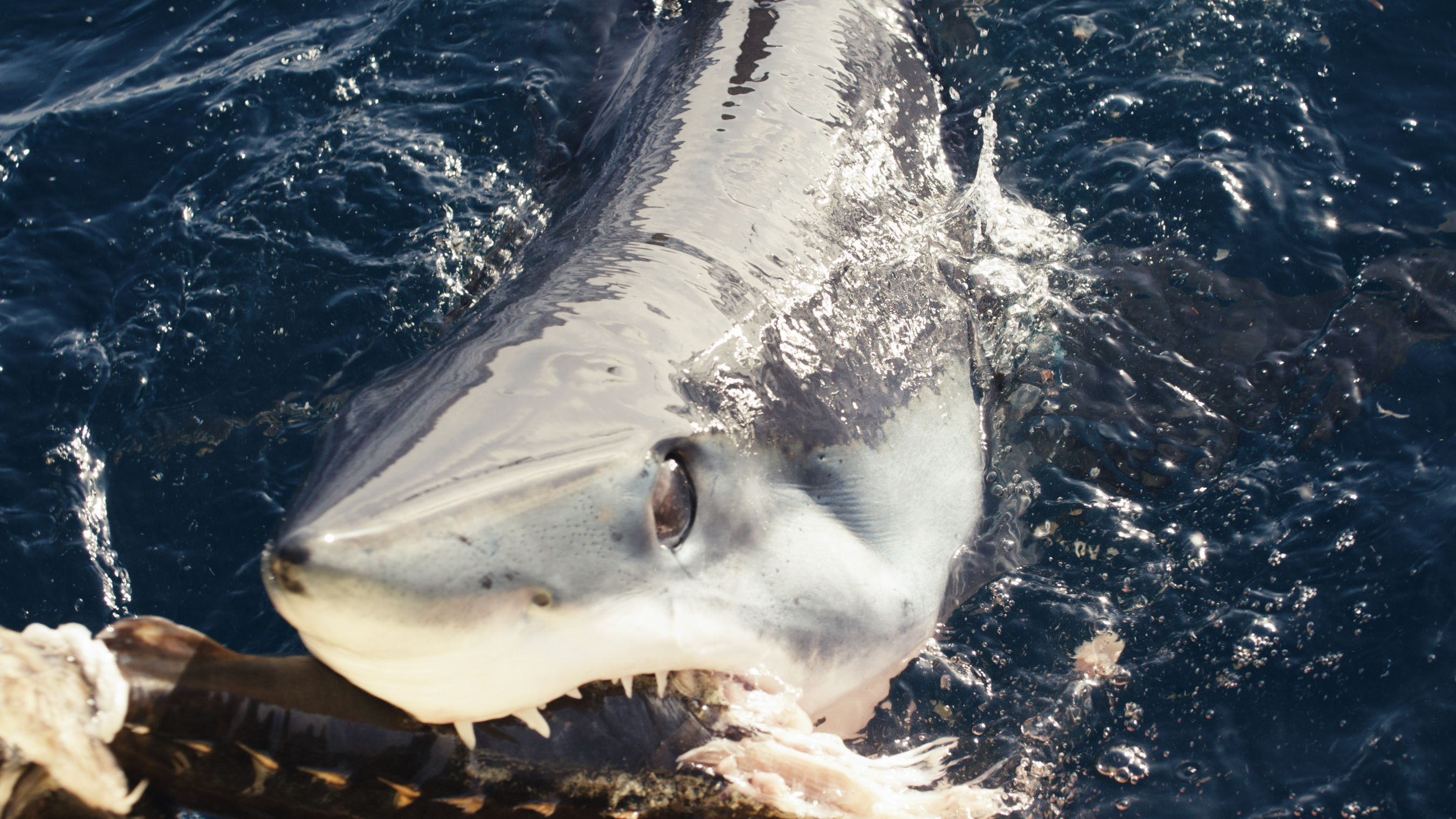In 2019, shark tagger Keith Poe was working off the coast of California when he hooked a surprisingly big “black mako” shark. The shark appeared larger and darker than shortfin makos (Isurus paucus), which are generally dark blue or gray with white undersides.
This sighting is the basis of the new Shark Week show “Black Mako of the Abyss,” where a team sets out to find more of these black makos in an attempt to work out exactly what Poe caught six years ago. Suggestions for the creature’s unusual appearance and size include genetic mutations and the potential for shortfin makos hybridizing with another species.
In the episode, Poe works with environmental scientist Kendyl Berna, marine biologist Tristan Guttridge and shark attack survivor Paul de Gelder as they travel 40 miles (64 kilometers) off the coast of California to lure ocean predators in the hope of attracting black makos. Their ultimate goal is to obtain tissue samples to conduct genetic analysis and find out what the mysterious animals really are.
During the show, the team lures sharks using a helicopter carrying hundreds of gallons of chum. They later deploy a white shark decoy to see if any makos interact with it — with the latter drawing out an aggressive, unusually dark mako shark.
This shark, like that in Poe’s original video, appears to have shortfin and longfin features, leading the team to speculate that it could be a longfin mako (Isurus paucus), or longfin/shortfin hybrid.
Unlike shortfins, longfin mako sharks are more elusive, living in deeper waters further out from coastlines. As a result, they’re less understood than their shortfin cousins, with big questions about their range and habitat — although sightings off California are particularly rare. Physically, their bodies are more slender than shortfins, and they have longer pectoral fins and darker coloration.
To establish whether the black makos are potentially longfins, the team released bait that encourages the sharks to breach, so they can see their size and physical characteristics more clearly. The captured footage revealed several shortfins, but one appeared to have pectoral fins far longer than the average, again raising the idea of a shortfin/longfin hybrid.
Shark hybridization is not unheard of. In 2019, scientists reported scalloped hammerhead (Sphyrna lewini) and Carolina hammerhead (S. gilberti) hybrids in the western North Atlantic, while in Australia in 2011, researchers found hybrids of the black-tip whaler shark species Carcharhinus tilstoni and C. limbatus.
While the Shark Week team tried to get samples from their black makos to see if they are hybrids, the sharks were too fast.
Experts say the potential for shortfin/longfin hybridization is unlikely. There is no evidence of the two species mating, and even if they did, any hybrid offspring would likely be sterile.
“Different species with naturally overlapping ranges typically don’t hybridise, if they did and the offspring were viable, the species would merge back into one,” Jess A.T. Morgan, principal scientist at the animal science division of the Department of Primary Industries, Queensland, Australia, told Live Science in an email.
“Natural hybridisation can and does occur in nature, but often only in restricted regions of species overlap called hybrid zones,” Morgan added. “Hybrids occasionally do survive in nature and are able to reproduce (this appears to be the case with black tip sharks) but in most cases they will be less fit than the pure species so don’t pass on their DNA.”
Morgan was a co-author on the blacktip hybrid study from 2011, and said DNA evidence is needed to establish if a weird-looking shark is a hybrid: “One thing we know about sharks is that differences in external appearance can be misleading,” she said. “A lot of species can be easily confused, particularly if they belong to the same genus and are not fully grown.”
Berna said another possibility is that the black makos are just longfins that are coming closer to the coastline, or they are shortfins with mutations that help them hunt in deeper waters, such as darker skin. Environmental changes could also potentially explain shifts in shark ranges — for example, climate change has been linked to tiger sharks (Galeocerdo cuvier) moving northwards over the last few decades.
“I think it’s possible that these black makos that we’re seeing are actually just longfin makos,” Berna told Live Science. “When you see a mako that isn’t supposed to be in these waters, and isn’t very documented in these waters, looking funny, then you would think ‘wow, that’s a strange looking shortfin mako,’ when in reality, maybe it’s actually a longfin, just in a different geographic range than what’s sort of accepted by science.”
Longfin makos tend to be found in more tropical waters, and are known off the coast of Mexico — but as ocean temperatures heat, it’s possible their distribution is also shifting north, Berna said. “Global warming, climate change — that’s constantly changing distributions of animals, as well as overfishing [changing] where they have availability of prey and food sources. There’s a lot of reasons that animals, and sharks in particular, can change their geographic distribution and ranges.”
Douglas Adams, a researcher at the Florida Fish & Wildlife Conservation Commission, said genetic analyses would be needed to answer these questions about the unusual makos found by the group. “Many questions remain regarding the range and habitat use of longfin makos,” he told Live Science in an email. “The ecology and biology of longfin makos are not well understood, but the ranges of many other fish species have been shifting with ocean warming and other factors.”
Berna said they are still hoping to get a sample to find out what these black makos are. “A genetic sample would be the absolute, highest form of confirmation that we could get. That, ultimately, is the goal.”
